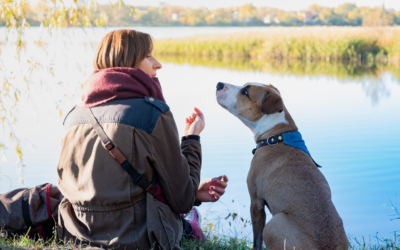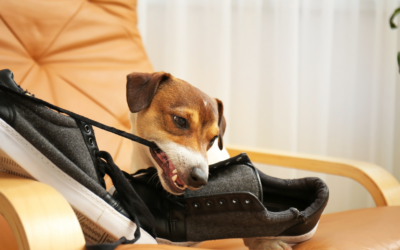Sleep is a really important behavior in all animals, and a lot of research in different species has shown that it is necessary. Across species, it’s generally agreed upon that sleep is important for learning, memory, behavior and emotional control, health, and quality of life.
Research in this area in dogs can be quite hard to do. Much of the research we have depends on owner opinion, perception, and recording of sleep. There are some studies that have placed activity monitors on dogs, but it can be hard to tell the difference between sleep and resting.. Finally, there is laboratory research but typically involves more invasive procedures where electrodes are placed on the dogs. Dogs need to be trained for the procedures and likely don’t sleep the way they would at home.
How much do dogs sleep?
There are a lot of differences in individual dogs in the amount of sleep they need or get. There can also be differences throughout their life.
One study compared 4 month old puppies and 12 month old dogs in terms of how much sleep they get. The younger puppies got more overall, and more throughout the day than the one year old dogs. Owners thought their puppies slept overnight for 7.0 hours (16 weeks), and 7.3 hours (12 months). During the day, they thought their dogs slept 3.5 hours at 16 weeks and 3.0 hours at 12 months.
A study looking at laboratory beagles with activity monitors measured their sleep during the daytime and nighttime. The dogs slept between 8.1 to 9.0 hours overnight, and between 3.6 and 4.1 hours during the day. We also know that older dogs do tend to sleep more, but it is more fragmented or interrupted.
The amount of time dogs are left alone at home also affects the rest or sleep that dogs are getting. One study looked at video observations of dogs while their owners were away. They looked at a few different body positions on video to tell is dogs were resting or perhaps sleeping. Dogs spent 76% of their time in lying positions (on their elbow, curled up, or lying relaxed). The researchers also looked at the difference between single dog and multi-dog households. They found that those in single dog households spent more time lying and resting or sleeping than in multi-dog households, where dogs were more likely to be active.
Sleep and behavior problems
While we know that sleep has many important and essential functions for all animals, it also likely plays a large role in behavior.
In a preliminary study looking at owner reports of sleep and behavior problems, owners were asked to record how much they thought their dogs were getting. Owners were also asked to rate their dogs behavior problems on a 0 to 10 scale, with 0 being a perfect dog with no behavior problems and 10 a dog that behaves in a way they cannot tolerate. Dogs sleeping less than 8-10 hours had higher reported behavior problems. This is definitely an area that needs more research as it could be important in behavior modification, further research with less subjective measurements needs to be completed.

Where do dogs like to sleep?
We likely all know the favorite sleeping spot for the dogs in our homes. It can be very different for individuals.
In a research study looking at choice tests in laboratory animals, older dogs were given different bed options to choose from. Dogs chose to use beds with soft bedding in them and also chose beds at floor level. It’s very possible that older dogs find elevated beds harder to get on or off of, especially in the dark.
A couple studies have also looked at the rooms in which dogs choose to sleep. A study looking at younger dogs under 12 months found 87% of the dogs chose to be around people overnight. Another study found 63% of dogs chose to sleep in the same room as people a majority of the night.
Should dogs sleep on the bed?
One question that often comes up is whether or not dogs should be allowed to sleep on the bed. Several studies have looked at the relationship between allowing dogs to sleep on their owners’ bed and the development of behavior problems.
In a survey study, dog owners were asked what they allow their dog to do. They also asked about any behaviour problems their dogs have. There was no difference between sleeping on the bed and behavior problem development. Another study looking at dogs going to a behavior clinic to see a veterinarian found that 20% of those dogs with aggression or separation-related problems slept on the bed. This data shows that sleeping on the bed is not associated with current behavior problems. It’s possible that anxious dogs like to be closer to people and people may not let aggressive dogs sleep on their bed.
I think preventing dogs from sleeping on the bed was likely some advice that came about when dominance theory was popular. People were likely concerned that a dog might feel “dominant” when being on the bed. If a dog's behavior could result in injury to people or themselves, then they probably shouldn't be on the bed. It’s not because it will make them feel like they are more powerful or more in control than the people on the bed.
I sometimes get asked if I let my dogs on the bed – I don’t. If you saw how much fur my two Australian Shepherds are losing at the moment, you might understand. One of my dogs sleeps on a dog bed or the floor, and often moves between the two. My younger dogs sleeps in her crate with a thick crate mat, by choice.
New research on the horizon
There is a lot of new research that has been coming out in the last couple decades. As our technology advances t will become easier and more applicable to our household dogs. For example, there is new research looking at positive and negative experiences dogs have and how that influences their sleep.
When it comes to behavior and training, I expect that we’ll be learning a lot more about sleep. For now, I think it’s important to consider the amount and quality of sleep that dogs are getting. Especially if there are behavior and training issues, we need to make sure that dogs are getting enough.
If you’re interested in more of the science behind this blog post, visit The Behaviory Blog which is my blog written for pet professionals, and covers the topic in greater depth with scientific references.



